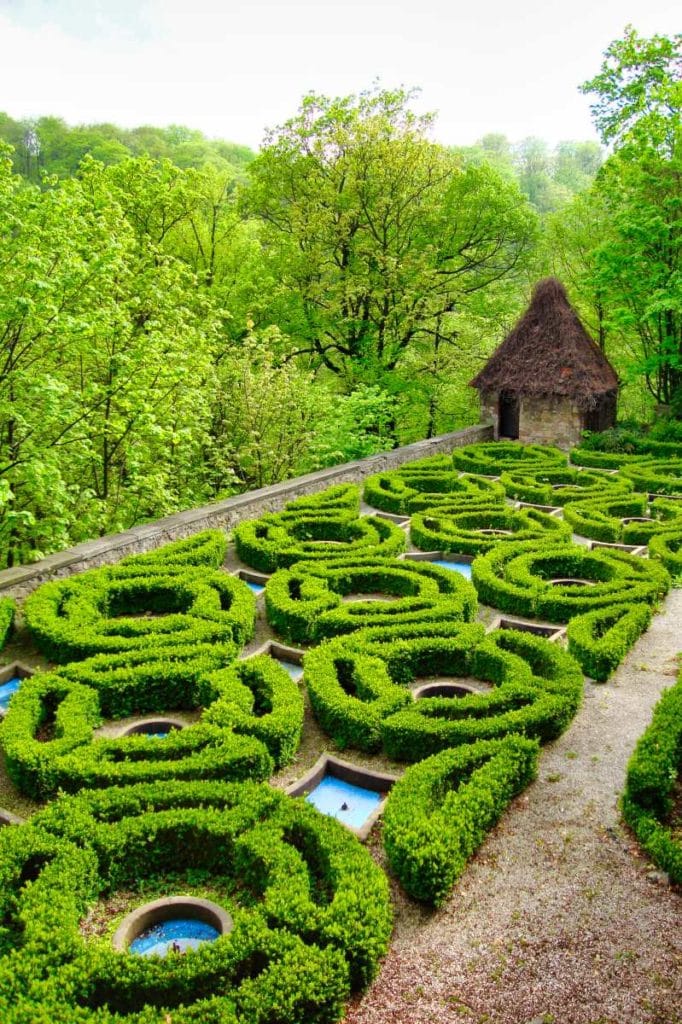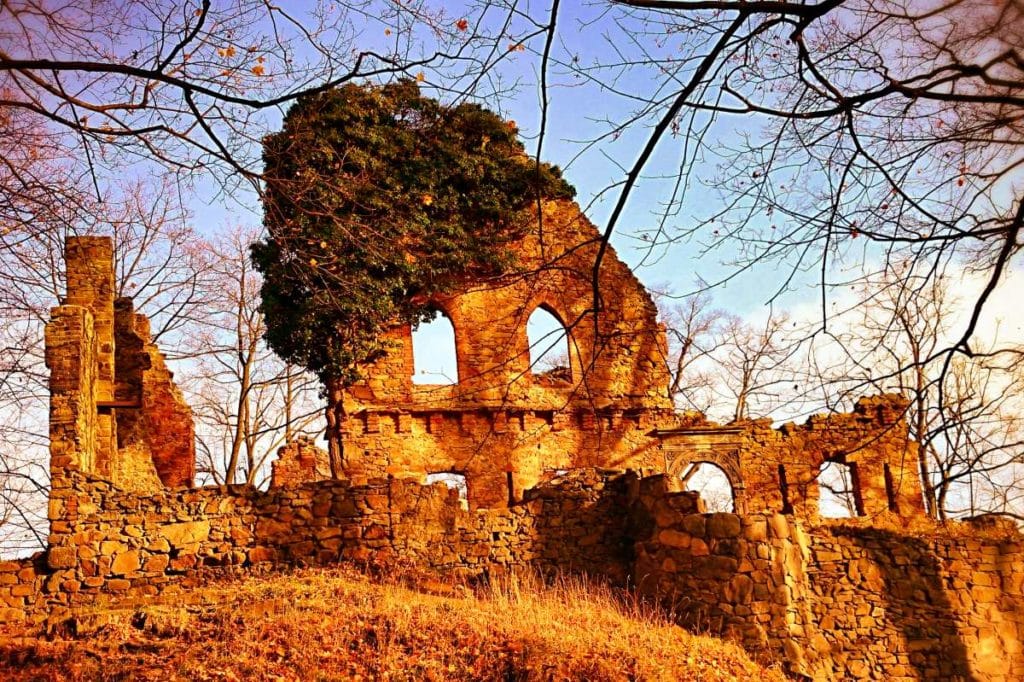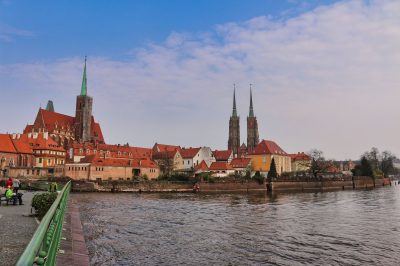Today we take you with us to Silesia. About 80 kilometers southwest of Wrocław, north of the city of Wałbrzych, not far from the Czech border, lies the largest castle in Silesia, Książ Castle or Schloss Fürstenstein, as it was formerly called. The castle has about 400 rooms, which makes it not only the largest complex of its kind in Silesia, but also one of the largest in Europe. The beautiful Książ Castle can be visited today, but it also has a dark past. Here you will learn everything you need to know about the castle and its history and get some practical tips for your visit.
The history of Książ castle
The castle can look back on an eventful past, which, however, cannot always be reconstructed exactly, especially for the Middle Ages. It was first mentioned in 1288, when Duke Bolko I of Schweidnitz had a castle built here because his residence in Świebodzice, which was not far away, was no longer up to date in military terms.
The perfect location
For the construction of the new castle he chose not just any location, but the picturesquely situated Fürstenberg, to which the German name of the castle can also be traced. The place was also called the gateway to Silesia and was supposed to secure the border with the Kingdom of Bohemia in the south. The castle was not only elevated and therefore difficult to capture, but also idyllically located in a forest. From then on, it not only served as a defensive position, but also became the ancestral seat of the Dukes of Schweidnitz.
Complicated ownership and the Hochberg family
Subsequently, the castle was repeatedly sold, mortgaged or bequeathed. The late Middle Ages brought a whole series of rulers for Fürstenstein, and the ownership relations are complicated. Ultimately, however, at the beginning of the 16th century it passed into the possession of the Hoberg family, which later called itself Hohberg and from 1740 Hochberg. The noble family was first raised to the rank of barons, then to counts and then to imperial counts. In the middle of the 19th century Hans Heinrich X. even received the dignity of a prince and he and his successors were now allowed to call themselves Princes of Pleß.
Modifications and extensions
At the beginning of the 17th century, significant reconstruction works took place and the castle was transformed into a Baroque chateau, which was later extended by a garden pavilion (that later served as the family crypt). They even allowed themselves another castle at the end of the 18th century, Alt-Fürstenstein, which was planned from the very beginning as a romanticizing ruin, reminiscent of the Middle Ages. Hans Heinrich XI also had a library built in the 19th century, which was one of the largest in Silesia and was later moved to the gatehouse. It is said to have contained over 60,000 volumes, but unfortunately many books were lost or destroyed after the Second World War. Then, at the beginning of the 20th century, a palm house was built, which still exists today and can be visited.

Apart from the Baroque reconstructions, the most drastic changes were made to the chateau between 1909 and 1923. Two huge castle wings in the neo-Renaissance style were added and the characteristic castle tower was given its current height and appearance. However, the Hochbergs overdid it a bit with the reconstructions, because the First World War and the economic crisis in 1923 led to the ruin of the family. At the beginning of the 20th century, the family was also marked by a number of scandals. Members of the house were either homosexual, married beneath status, had affairs, or had to marry their stepmothers.

Fürstenstein Castle and the Nazis
In 1938, Hans Heinrich XV, the last owner of the castle from the Hochberg family, died. Other family members were scattered to the four winds, joined the Polish army in exile or the British Air Force during the Second World War, or were murdered by the Gestapo. Step by step, the Nazis confiscated the castle. The Hochbergs’ open rejection of the Nazis and kinship ties to Winston Churchill eventually ensured that the illustrious, English-born Prince Daisy von Pless was expelled from the castle by the Nazis and relocated to a villa, where she died in 1943. The Nazis now began to “secure” the furnishings of the castle, which meant nothing more than the confiscation of valuable cultural assets.
They subsequently decided to build a system of tunnels as part of “Project Riese”, which was presumably intended to serve as a retreat for the Nazi elite if the Wolf’s Lair in Masuria had been taken. Italian prisoners of war and inmates of the concentration camp Groß Rosen had to excavate tunnels here and in the entire Owl Mountains under horrible conditions, while Fürstenstein Castle was intended to serve Hitler as a representative residence. Incidentally, the tunnels made international headlines a few years ago when a train was suspected to be here, which, depending on the report, was either full of gold or contained the Amber Room. Numerous treasure hunters were then drawn to the tunnels, but nothing was found.
Książ Castle after the war
What the Nazis had not already removed from the castle was looted after the war by Soviet soldiers who occupied the castle. In the following decades, Fürstenstein Castle was used by various institutions as an administrative seat. Since the fall of communism it has been owned by the city of Wałbrzych, former German Waldenburg. Today you can visit Fürstenstein Castle. The complex has been extensively restored and, in addition to the actual castle, also includes the beautiful terraces and several farm buildings. Today, there are several galleries and pubs on the extensive grounds and many rooms have been restored and furnished with historical furniture.
What can you see here?
In the following section we would like to introduce you to the most beautiful places on and around the castle.

Maximilian Hall
The Maximilian Hall is the absolute highlight of Fürstenstein Castle. The two-story hall is a baroque masterpiece and one does not know where to look first in view of the Italian marble, the magnificent mirrors and the many gold. On the second floor there are three small balconies where the court orchestra used to perform. Today you can even get married here, but you have to pay 1500 złoty per three quarters of an hour to rent it. In 2014, by the way, there was a roof fire that occurred right above the valuable hall. Thanks to the courageous intervention of the fire department, the fire destroyed about 500m² of roof, but the Maximilian Hall remained intact.
White and Green Salon
The White Salon, in contrast to the many Baroque rooms, is in the Rococo style. Originally, it was called the Red Salon, but during reconstruction it was given its current white color. Besides the White Salon, there is another lounge. It is called the Green Salon, although it is also almost completely white. Magnificent baroque stuccowork dominates the scenery here, and some portraits of the von Hochberg family are also exhibited here.
Game Salon
Behind the name game salon is exactly what you would expect given the name. The small room is equipped with, among other things, a piano and a table. One can well imagine how the high lords used to gather here to make music together or play a game of chess.

Black Courtyard
The wonderful courtyard of Książ Castle is an oasis of peace and ideal for a little break. From one of the tables you can admire the interesting mix of medieval walls and a neo-Renaissance wall with many reliefs.
Chinese Salon
The name Chinese Salon goes back to its tapestries. Such salons were once very popular with nobles and were supposed to bring a certain exoticism to Europe. On the walls you can see all kinds of decorations and floral motifs, as well as several peacocks. The Venetian chandelier and the delicate stucco work on the ceiling are also particularly beautiful. In the past, the hall, which also includes several marble objects, served as a tea room for the Hochberg family.

The terraces
A total of 13 gardens were laid out over time in terraces around the castle. They have different geometric shapes, sometimes horseshoes, sometimes crosses and sometimes oval hedges, interrupted by fountains and flowerbeds. Here you can relax and recover from the tour of the castle.

The castle park
Already at the end of the 19th century, the lords of the castle had a park landscape of about 125 hectares laid out below Fürstenstein Castle. Here you can walk for hours in the shade of some historical lime trees and other trees and enjoy the nature. The most interesting place in the castle park is the mausoleum of the Hochberg family. It is housed in an old garden pavilion and served as a burial place for the Hochberg family from 1905.
The palm house
About 2 kilometers from the castle, in the district of Lubiechów, stands the Palm House. It has a 15 meter high dome and was built in Art Nouveau style. Hans Henry XV had it built shortly before the outbreak of the First World War for his wife, Daisy, who died during the Second World War. In addition to the reconstruction of the palace, the Palm House was another reason for the ruin of the family, as it swallowed the proud sum of 7 million gold marks. In the palm house of Fürstenstein Castle, almost 250 different plant species from different climatic zones are presented on almost 2000 m². Besides date trees, there are also bamboos, cacti, agaves and Poland’s only bonsai exhibition to admire.

Wąwóz Książ with Old Castle
The immediate surroundings of the castle are characterized by the Wałbrzych Hills, which together with the Falcon Mountains and the Owl Mountains form the western part of the Central Sudety. You can get an impression of the partly untouched nature during a short walk. Below the castle runs the Wąwóz Książ, a four kilometer long gorge. While Książ Castle sits enthroned on one side, the “ruins” of the Old Castle from the 18th century lie on the opposite side of the gorge, through which the Pełcznica River flows.
On the so-called Hochberg Trail you can hike through one of the most beautiful gorges of the Sudety Mountains. The well-secured Hochberg trail gives you a great view of the castle along the way. Just follow the signs Ścieżka Hochbergów to find the way. Along the way, you’ll also come across the remains of a Nazi labor camp.

Your visit to the castle
The castle is open daily from 11 am to 6 pm. Occasionally, night tours are offered on Fridays and Saturdays. You can also explore the castle’s underground on special tours. For information on tours, prices and times, visit the castle’s website. Here* you can book a tour that starts in Wroclaw, lasts five hours, and includes an English- or German-language tour of the castle.
Overnight stay on the spot
You want to spend the night directly at the foot of the castle? No problem. There are several hotels in the immediate overnight stay, which are only 100 to 200 meters away from the castle.
- Hotel Książ*. Hotel Książ is housed in three former outbuildings of the castle. In the past, crowned heads and politicians used to stay here when visiting the owners of the castle, including Frederick the Great, Kaiser Wilhelm I, Winston Churchill and Tsar Nicholas I. Given this stately ambience, the prices are more than moderate.
- Hotel przy Oślej Bramie*. The ” Hotel at the Donkey’s Gate”about 200 meters from the castle spoils its guests with a rustic and cozy ambience. In the past, the buildings served as a post office, police station with a detention cell and laundry, so you can also spend the night here in a unique historical environment.
Book recommendations
Classic tour guide about Poland, that of course also contains a lot of information on Silesia
No products found.
This book presents Silesia, but also the neighbouring areas of Bohemia and Moravia.
No products found.
Not very up to date, but a great companion if you are interested in the architecture of Lower Silesia
No products found.



